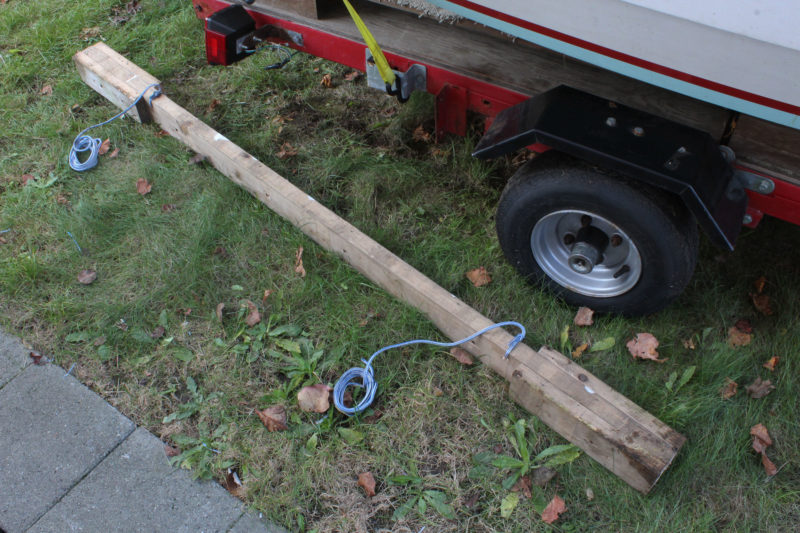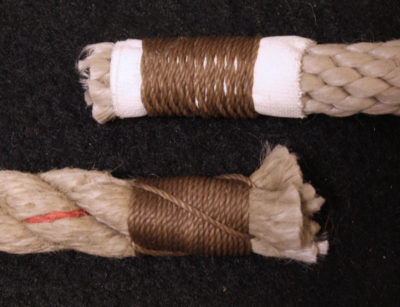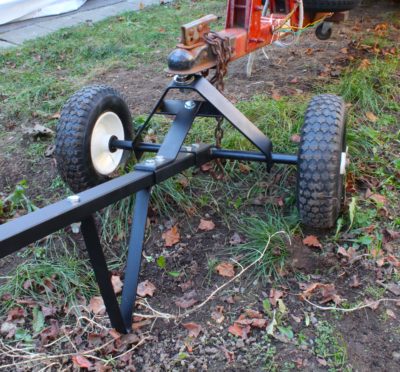 Photographs and video by the author
Photographs and video by the authorThe dolly has made it much easier for me to move over a half ton of boat and trailer.
If I had my druthers, I wouldn’t have to man-haul my boat trailers to get them to the car to hitch them up. The caster on a trailer jack works okay on pavement, and only marginally in my backyard in the summer when the lawn is dry and hard, but on gravel and damp sod it’s a struggle to get it to roll or pivot.
I recently sprang for the MaxxHaul trailer dolly and wish I’d bought one sooner. It took about 20 minutes to assemble; metric sockets would have been much quicker than the crescent wrenches I had to resort to. The dolly weighs 31.7 lbs and feels quite solid. It comes with a 1-7/8″ ball, which fits the couplers on my two small trailers. The 12″ x 4″ pneumatic tires are like those used on wheelbarrows and roll easily on pavement, grass, and gravel. The dolly has a stable 24″ wheelbase and the wheels spin on bearings slipped over a 0.9″ steel tubing axle. A sturdy 1/4″-thick steel bracket supports the hitch ball and is connected by a brace to the 4′ long handle.

To roll a trailer-jack wheel across this soft lumpy ground, I had to lay down a path of boards. The dolly isn’t bogged down by it.
The first time I used the dolly—on the trailer I don’t have outfitted with a jack—I was impressed with how easily it can lift the trailer’s tongue from the ground. Raising the handle lowers the hitch ball, and after the ball is steered under the socket of the trailer’s coupler, lowering the handle lifts the tongue. The long handle not only provides a lot of mechanical advantage—4.4 to 1—but also entirely eliminates the back strain of lifting the tongue up by hand. I just have to put my weight on the handle to push it down. The tongue weight on the trailer I’ve been using the dolly on is 137 lbs and the weight of the trailer and the Caledonia yawl it carries is between about 1200 lbs. MaxxHaul sets the dolly’s capacity at 600 lbs, so even though I’m doubling the working weight, the dolly hasn’t shown any sign that it’s suffering under the load.
The handle comes to a convenient height for pulling; it just lines up with my arms and there’s no fighting its angle. Pushing is almost as easy, I can set the handle in the crease of my hips if I need extra power. Steering with the dolly is a breeze—it easily spins around the hitch. Lowering the handle moves the hitch ball a bit past directly over the axle and presses the handle down on the stand that’s bolted to its backside.
My backyard has a bit of a slope down to the sidewalk next to it, and while it’s neither long nor steep, it’s too much for me to push a half ton of trailer and boat up it. Although I can’t simply pull or push the dolly to get the boat up the slope, I can use the dolly to take advantage of the leverage provided by the long boat-trailer tongue. The 13′6″ trailer tongue gives me a nearly 3:1 mechanical advantage over the 4′8″ wheelbase. Chocking one wheel and pushing the tongue to that side will roll the other wheel forward.

The wheel chock I use for hauling the trailer uphill is tied to the trailer and follows close behind both wheels, allowing one to roll forward, while the other is prevented from moving back.
To make leverage work in a single-handed operation, I made chocks to follow the wheels. I added 1″-thick slabs of scrap wood to both ends and both sides of a 2×4 that spans from one wheel to the other. Cords, tied between the 2×4 and brackets forward of the wheels, pull this device forward, so all I have to do is push the tongue back and forth sideways and the chock lets the wheels roll forward but not backward. The dolly makes it very easy to move the tongue from side to side and ratchet the trailer uphill.
The fewer impediments that I have to getting a boat to the water, the more likely I’ll be able to get on the water more often. The MaxxHaul trailer dolly will get most of the heavy lifting out of the way.![]()
Christopher Cunningham is the editor of Small Boats Magazine.
If you’d prefer to upgrade your trailer jack with dual 10″ pneumatic tires, see Ben Fuller’s review of the Croft wheel kit.
The MaxxHaul 70225 trailer dolly is available from online retailers. I purchased mine through Amazon for $50.80.
Is there a product that might be useful for boatbuilding, cruising, or shore-side camping that you’d like us to review? Please email your suggestions.












The moving wheel chock is genius! Simple, effective, and easily made from pieces from the scrap pile. Thanks for sharing the review.
Genius.
I had been thinking about buying one of these and your article gave me the push, so I recently went out and bought a nearly identical trailer dolly for my Welsford Navigator. I barely have room in my garage for the boat plus shop/car and every inch counts and there’s enough weight on the tongue that jockeying it around by hand is no fun. This was $60 well spent! Thanks for the push 🙂
I use a single moving wheel block for the truck on boat ramps. Not as needful with auto transmission but I called it my clutch saver with a manual.
I’m wondering if the 600-lb limit is tongue weight?
The 600-lb figure is for gross trailer weight, not tongue weight. Here’s the info from the manufacturer website:
“The MaxxHaul Trailer Dolly makes an easy job of maneuvering trailers weighing up to 600 pounds.”
I think part of that limitation is to set expectations for the user. Using weight estimates for my Caledonia yawl (600 lbs) and its drift-boat trailer (400 lbs), I’ve been usind the dolly to move 1,000 lbs. The dolly has held up under that task; it’s about my limit.
I hooked this super-handy electric trailer dolly up to my boat and trailer (3500lbs) and dragged it out of the garage and downside yard, no problem. Batteries came fully charged. Yes, you have to pay attention to how much power you use on the switch and yes, it will lift and move around on you, but with no issues whatsoever. Made my life EASY!!! If you just hit full power on the switch it’s going to spin all day on you. I barely use the power and move it no problem. The angle finder on my side yard said 4 degrees incline and absolutely zero issues. I also have a tandem trailer and it maneuvers it around with ease.